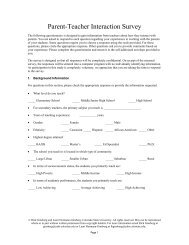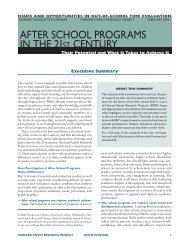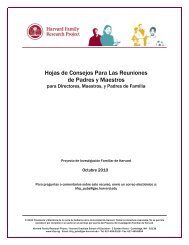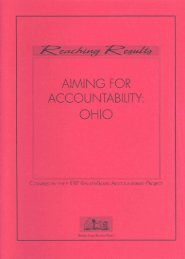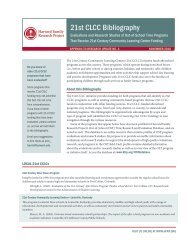Download a PDF of this case study - Harvard Family Research Project
Download a PDF of this case study - Harvard Family Research Project
Download a PDF of this case study - Harvard Family Research Project
Create successful ePaper yourself
Turn your PDF publications into a flip-book with our unique Google optimized e-Paper software.
Overlapping Spheres <strong>of</strong> Influence<br />
School<br />
Community<br />
Child<br />
<strong>Family</strong><br />
By espousing <strong>this</strong> theory <strong>of</strong> overlapping spheres, Epstein provides schools with a vision <strong>of</strong><br />
what they can strive to be: “family-like schools.” These schools recognize each child’s<br />
individuality and treat each child as special. They welcome all families, not just those that<br />
are easy to reach. Likewise, her theory supports “school-like families,” which recognize<br />
children as students and reinforce the importance <strong>of</strong> school, homework, and other<br />
activities that build on students’ feelings <strong>of</strong> success. Epstein (1995) argues that when<br />
families, schools, and communities adopt one another’s practices to benefit children,<br />
learning and caring communities are created.<br />
In sum, Epstein conducted and reviewed research and presents it in an accessible and<br />
convincing way that conveys to schools the benefits <strong>of</strong> partnerships, the range <strong>of</strong><br />
involvement activities these partnerships represent, and the complementary roles <strong>of</strong><br />
family, school, and community in children’s learning.<br />
II. Develop a National Network <strong>of</strong> Partnership Schools<br />
By building a solid research base, Epstein created a stronger foundation on which to<br />
develop a national network <strong>of</strong> partnership schools. Still, another challenge that many<br />
schools face is their isolation from other schools and other sources <strong>of</strong> support, such as<br />
their local communities, school districts, and state departments <strong>of</strong> education. To address<br />
<strong>this</strong> challenge, Epstein strengthened the Network by designing a technical assistance<br />
structure that connects schools to other groups that will support their partnership work.<br />
Design a Technical Assistance Structure<br />
The Network counters schools’ isolation through several components <strong>of</strong> its technical<br />
assistance structure. These components are facilitating links between and among<br />
stakeholders; providing prescribed and tailored support to Network members; encouraging<br />
the integration <strong>of</strong> partnership programs with other school reforms; creating reciprocal<br />
information exchange between the Network and its members; and disseminating<br />
information to policymakers and practitioners. The following sections describe how each <strong>of</strong><br />
these organizational steps is informed by research, and how the Network has succeeded<br />
in developing, implementing, sustaining, and improving partnership programs in schools.<br />
Link to a National Organization, Other Schools, Districts, and States<br />
As part <strong>of</strong> its effort to build the capacity <strong>of</strong> schools, the Network facilitates linkages among<br />
schools and between schools and other key institutional players that can support schools.<br />
The web <strong>of</strong> support for schools includes education departments at the district and state<br />
- 6 -





